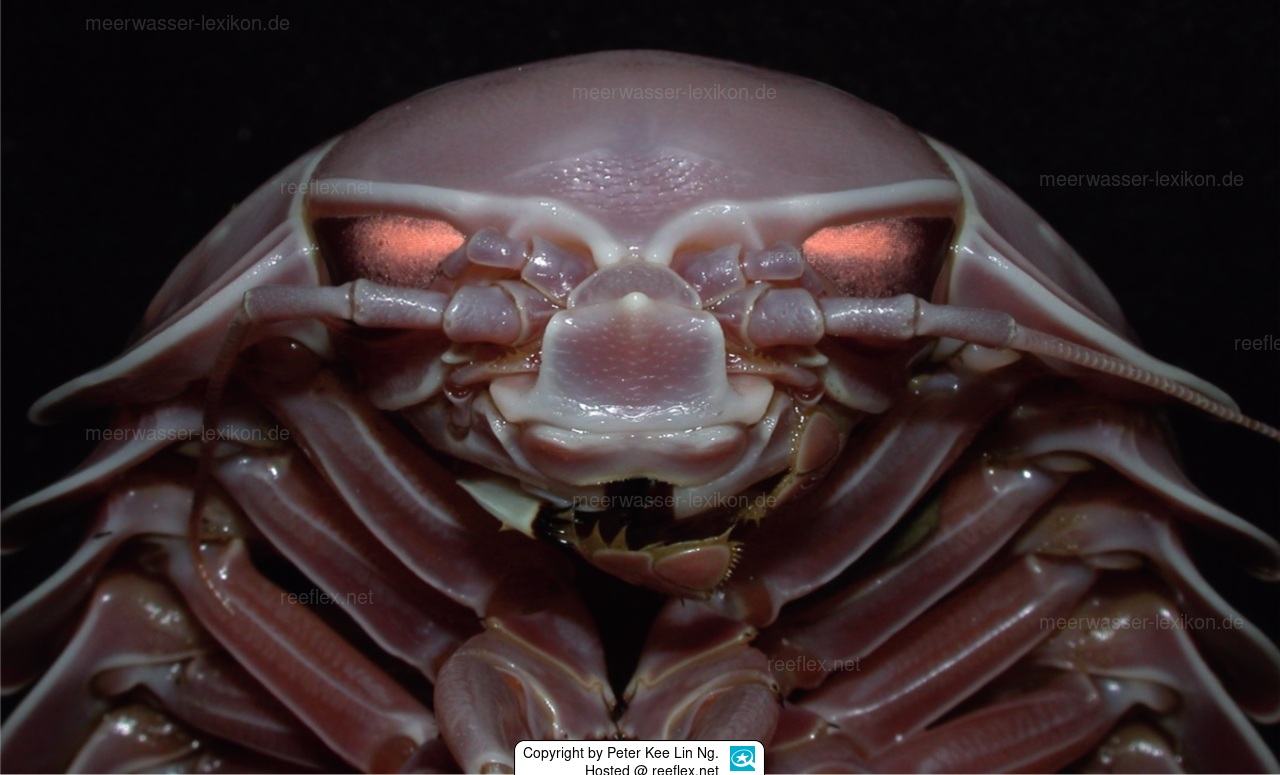Info
Bathynomus kensleyi belongs to the family Cirolanidae, the isopod crustaceans, and 20 species of the genus Bathynomus are currently known.
Researchers, scientists and resource-oriented companies are penetrating deeper and deeper into the darkest marine zones and regularly discovering new, sometimes strange, bizarre and unknown creatures, so that even more new species of the genus Bathynomus can be expected in the future.
In the appendices there are some scientific documents that cast doubt on the occurrence of Bathynomus kensleyi in Indian waters, as three out of four of these records were misinterpretations, see "DNA barcoding of the supergiant isopods from Bathynomus kensleyi Lowry & Dempsey, 2006 (Cirolanidae) and a molecular biology comparison of B. jamesi Kou, Chen & Li, 2017".
Isopod crustaceans are deep-sea scavengers that feed on carrion, mainly organic remains of various organisms that have fallen from the upper layers of the ocean to the seafloor, including the remains of fish, cephalopods and decapods, but Bathynomus can also eat other deep-sea organisms.
My first association when I saw the great first photo of Bathynomus kensleyi, immediately went to the science fiction Serie "Alien vs. Predator", geheimnisvollen, außerirdischen Fantasiewesen
Isopod crustaceans are deep-sea scavengers that feed on carrion, mainly the organic remains of various organisms that have fallen from the upper layers of the ocean to the sea floor, including the remains of fish, cephalopods and decapod crustaceans, but Bathynomus can also eat other deep-sea organisms.
We would like to thank Dr. Peter Kee Lin Ng, Singaporean carcinologist and ichthyologist at the National University of Singapore, who is also the director of the Lee Kong Chian Natural History Museum and the Tropical Marine Science Institute, for photographing this large isopod and allowing the Marine Encyclopedia to use the photo.
Isopod crustaceans are only distantly related to their better-known relatives, the crabs, shrimps and lobsters
It goes without saying that this isopod is not suitable for a home aquarium.
Researchers, scientists and resource-oriented companies are penetrating deeper and deeper into the darkest marine zones and regularly discovering new, sometimes strange, bizarre and unknown creatures, so that even more new species of the genus Bathynomus can be expected in the future.
In the appendices there are some scientific documents that cast doubt on the occurrence of Bathynomus kensleyi in Indian waters, as three out of four of these records were misinterpretations, see "DNA barcoding of the supergiant isopods from Bathynomus kensleyi Lowry & Dempsey, 2006 (Cirolanidae) and a molecular biology comparison of B. jamesi Kou, Chen & Li, 2017".
Isopod crustaceans are deep-sea scavengers that feed on carrion, mainly organic remains of various organisms that have fallen from the upper layers of the ocean to the seafloor, including the remains of fish, cephalopods and decapods, but Bathynomus can also eat other deep-sea organisms.
My first association when I saw the great first photo of Bathynomus kensleyi, immediately went to the science fiction Serie "Alien vs. Predator", geheimnisvollen, außerirdischen Fantasiewesen
Isopod crustaceans are deep-sea scavengers that feed on carrion, mainly the organic remains of various organisms that have fallen from the upper layers of the ocean to the sea floor, including the remains of fish, cephalopods and decapod crustaceans, but Bathynomus can also eat other deep-sea organisms.
We would like to thank Dr. Peter Kee Lin Ng, Singaporean carcinologist and ichthyologist at the National University of Singapore, who is also the director of the Lee Kong Chian Natural History Museum and the Tropical Marine Science Institute, for photographing this large isopod and allowing the Marine Encyclopedia to use the photo.
Isopod crustaceans are only distantly related to their better-known relatives, the crabs, shrimps and lobsters
It goes without saying that this isopod is not suitable for a home aquarium.







 Dr. Peter Kee Lin Ng, Singapur
Dr. Peter Kee Lin Ng, Singapur





